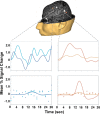The neural bases of the short-term storage of verbal information are anatomically variable across individuals
- PMID: 17928441
- PMCID: PMC6672855
- DOI: 10.1523/JNEUROSCI.1573-07.2007
The neural bases of the short-term storage of verbal information are anatomically variable across individuals
Abstract
What are the precise brain regions supporting the short-term retention of verbal information? A previous functional magnetic resonance imaging (fMRI) study suggested that they may be topographically variable across individuals, occurring, in most, in regions posterior to prefrontal cortex (PFC), and that detection of these regions may be best suited to a single-subject (SS) approach to fMRI analysis (Feredoes and Postle, 2007). In contrast, other studies using spatially normalized group-averaged (SNGA) analyses have localized storage-related activity to PFC. To evaluate the necessity of the regions identified by these two methods, we applied repetitive transcranial magnetic stimulation (rTMS) to SS- and SNGA-identified regions throughout the retention period of a delayed letter-recognition task. Results indicated that rTMS targeting SS analysis-identified regions of left perisylvian and sensorimotor cortex impaired performance, whereas rTMS targeting the SNGA-identified region of left caudal PFC had no effect on performance. Our results support the view that the short-term retention of verbal information can be supported by regions associated with acoustic, lexical, phonological, and speech-based representation of information. They also suggest that the brain bases of some cognitive functions may be better detected by SS than by SNGA approaches to fMRI data analysis.
Figures


References
-
- Andres M, Seron X, Olivier E. Contribution of hand motor circuits to counting. J Cogn Neurosci. 2007;19:563–576. - PubMed
-
- Bunge SA, Kahn IA, Wallis JD, Miller EK, Wagner AD. Neural circuits subserving the retrieval and maintenance of abstract rules. J Neurophysiol. 2003;90:3419–3428. - PubMed
-
- Chao L, Knight R. Contribution of human prefrontal cortex to delay performance. J Cogn Neurosci. 1998;10:167–177. - PubMed
-
- D'Esposito M, Postle BR. The dependence of span and delayed-response performance on prefrontal cortex. Neuropsychologia. 1999;37:1303–1315. - PubMed
-
- D'Esposito M, Postle BR. Neural correlates of processes contributing to working memory function: evidence from neuropsychological and pharmacological studies. In: Monsell S, Driver J, editors. Control of cognitive processes: attention and performance XVIII. Cambridge, MA: MIT; 2000. pp. 579–602.
Publication types
MeSH terms
Grants and funding
LinkOut - more resources
Full Text Sources
Miscellaneous
